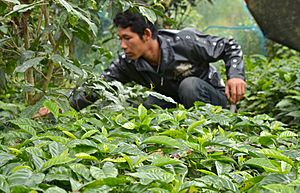Coffee production in Thailand facts for kids
Did you know that Thailand is one of the world's top coffee producers? Even though it's a big coffee grower, many people don't know much about Thai coffee. For a long time, Thailand mainly grew a type of coffee called Robusta. This coffee was often used in instant coffee. But now, Thailand is becoming famous for its special Arabica and fine Robusta coffees.
What's really cool about Thai coffee is that most of it stays in Thailand! They don't export much. There's a busy and friendly coffee community there. Farmers, coffee roasters, cafes, and customers all work together. This makes coffee growing in Thailand good for both the economy and the environment.
Contents
A Royal Start to Coffee
Thailand started growing coffee later than some other countries. In the 1970s, King Bhumibol Adulyadej had a great idea. He started projects in northern Thailand. These projects helped local people grow crops like coffee. Growing coffee gave them a new way to earn money. Thailand began exporting coffee in 1976.
Where Coffee Grows in Thailand
Different types of coffee grow in different parts of Thailand. Arabica coffee beans are mostly grown in northern Thailand. Robusta coffee beans are grown in the southern parts of the country.
Robusta Coffee in the South
Robusta coffee (Coffea canephora) is grown in several southern provinces. These include Chumphon Province, Surat Thani Province, and Nakhon Si Thammarat Province. Farmers grow Robusta coffee on a very large area, about 67,832 hectares. This produces about 80,000 tons of Robusta coffee each year. About a quarter of this Robusta coffee is used in Thailand. It's made into instant coffee, roasted beans, or ground coffee.
Arabica Coffee in the North
In northern Thailand, farmers grow Arabica coffee. This region is near the borders with Myanmar and Laos. It's sometimes called the "Golden Triangle" area. Arabica coffee is a good crop for farmers, including the hill people who live in the highlands.
Organic coffee grows well in the highlands. These areas are usually between 800 and 1200 meters (about 2,600 to 3,900 feet) above sea level. Coffee plants grow both in shady spots and in sunny open fields. Farmers also grow coffee alongside fruit trees. This is called intercropping.
Special Thai Coffees
In 2015, two special types of Thai coffee became very famous. These are Doi Tung and Doi Chang coffee. They received a special status from the European Union. This status means they are protected, like "Champagne" or "Parma ham". It shows that these coffees are unique and come from a specific place.
Coffee Production Numbers
According to information from 2013, Thailand produced 50,000 tons of coffee. This coffee was grown on 51,000 hectares of land. This put Thailand at 18th in the world for coffee production.
Currently, northern Thailand grows about 10,000 tons of Arabica coffee. It also grows about 30,000 tons of Robusta coffee.
Thai Coffee for Thais
Thailand has high taxes on coffee imported from other countries. This makes foreign coffee very expensive for coffee shops. So, you are more likely to find a blend of Thai coffee with a little bit of coffee from Brazil or Colombia. It's rare to find only foreign coffee in a Thai coffee shop.



